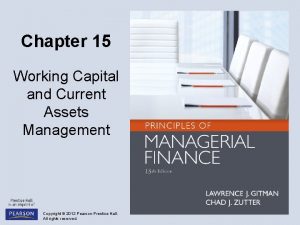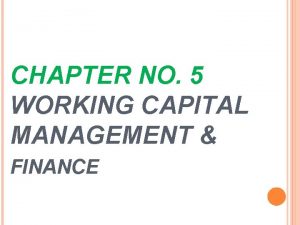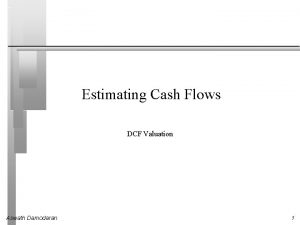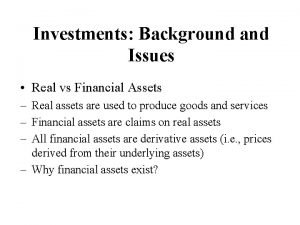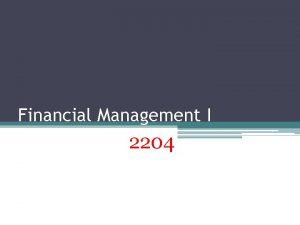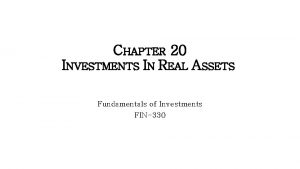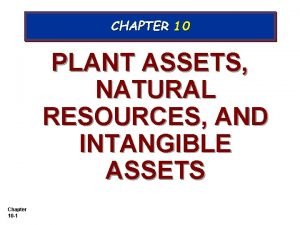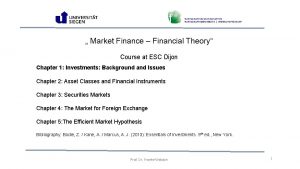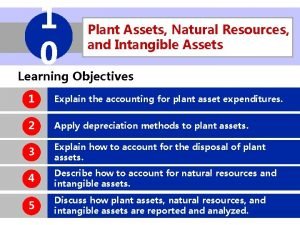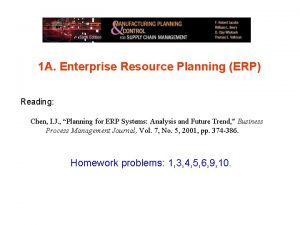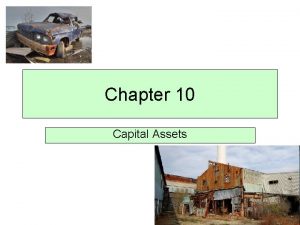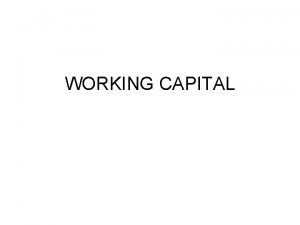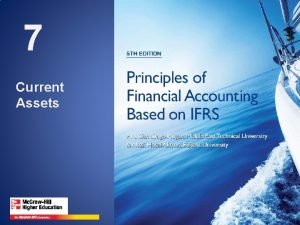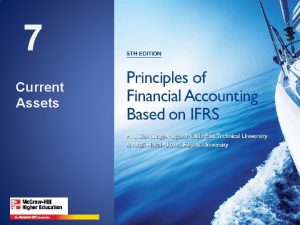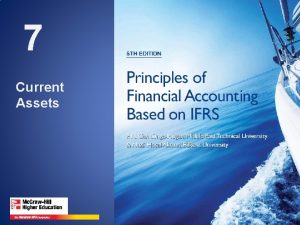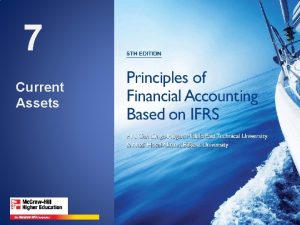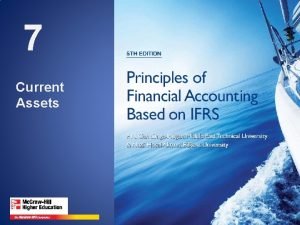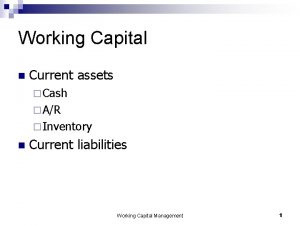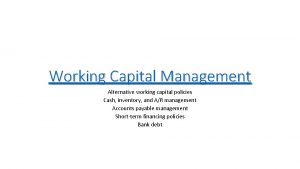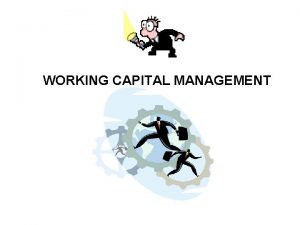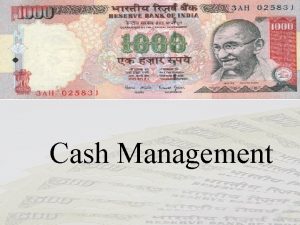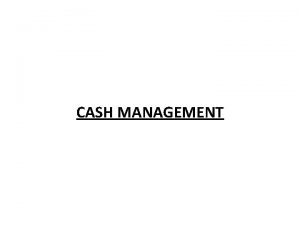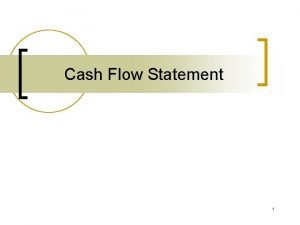Current Assets Working Capital Current Assets Cash in



















- Slides: 19

Current Assets & Working Capital • Current Assets – Cash in Hand & at Bank – Debtors – Stock • Current Liabilities – Creditors

Current Assets & Working Capital Manufacturing Process Stocks Purchases Wages Sales CASH Simple Manufacturing Organisation

Working Capital Cycle Credit Purchases Creditors Manufacturing Process Stocks Purchases Payment to Suppliers Credit Sales Wages CASH Debtors Payment by Customers “The Capital available for conducting the day-to-day operations of the business” Working Capital = Current Assets - Current Liablilities

Working Capital Cycle • Generates profit (hopefully) • Requires a cash investment (usually) £ 1 in generates £(Gross Profit) out

Question Can an organisation survive in the long term selling all its profits at a loss?

Working Capital Cycle Credit Purchases Creditors Manufacturing Process Stocks Purchases Payment to Suppliers Credit Sales Wages CASH Debtors Payment by Customers How long does it take money to go round the working capital cycle?

Working Capital Cycle Credit Purchases Creditors Manufacturing Process Stocks Purchases Payment to Suppliers Wages CASH Credit Sales Debtors Payment by Customers N 1 days Time to pay its bills – i. e. pay creditors – N 1 days

Working Capital Cycle N 2 days Credit Purchases Creditors Manufacturing Process Stocks Purchases Payment to Suppliers Wages CASH Credit Sales Debtors Payment by Customers N 1 days Time to pay its bills – i. e. pay creditors – N 1 days Time taken to convert raw materials to sold products – N 2 days

Working Capital Cycle N 2 days Credit Purchases Creditors Manufacturing Process Stocks Purchases Payment to Suppliers Wages CASH Credit Sales Debtors Payment by Customers N 3 days N 1 days Time to pay its bills – i. e. pay creditors – N 1 days Time taken to convert raw materials to sold products – N 2 days Time before cash is received from customers – N 3 days

Working Capital Cycle N 2 days Credit Purchases Creditors Manufacturing Process Stocks Purchases Payment to Suppliers Credit Sales Wages CASH Debtors Payment by Customers N 3 days N 1 days Time to pay its bills – i. e. pay creditors – N 1 days Time taken to convert raw materials to sold products – N 2 days Time before cash is received from customers – N 3 days Working Capital Cycle time = N 2 + N 3 – N 1

‘Mr JIT’ Manufacturer N 2 days Credit Purchases Creditors Manufacturing Process Stocks Purchases Payment to Suppliers Credit Sales Debtors Wages CASH Payment by Customers N 3 days N 1 days Time to pay its bills – i. e. pay creditors – N 1 days 45 days Time taken to convert raw materials to sold products – N 2 days 15 days Time before cash is received from customers – 45 days Working Capital Cycle time = N 2 + N 3 – N 1 N 3 days 15 days

‘Pile-em-high’ Food Retailer N 2 days Credit Purchases Creditors Manufacturing Process Stocks Purchases Payment to Suppliers Credit Sales Debtors Wages CASH Payment by Customers N 3 days N 1 days Time to pay its bills – i. e. pay creditors – N 1 days 130 days Time taken to convert raw materials to sold products – N 2 days 5 days Time before cash is received from customers – 1 days Working Capital Cycle time = N 2 + N 3 – N 1 N 3 days -124 days


Organisational Cash Flow Model Manufacturing Process Stocks Creditors Debtors CASH Expenses Indirect Wages Rent Bills Advertising Costs Promotional Costs R&D Tax and Dividends Tax on Profits Dividends to Shareholders

Organisational Cash Flow Model Manufacturing Process Stocks Creditors Debtors CASH Tax and Dividends Expenses Overdraft Short Terms Cash Escrow Deposits

Organisational Cash Flow Model Manufacturing Process Stocks Creditors Debtors CASH Expenses Tax and Dividends Overdraft Deposits Fixed Assets Long Terms Cash/Funds Shares

Organisational Cash Flow Model Manufacturing Process Stocks Creditors Debtors CASH Expenses Tax and Dividends Overdraft Deposits Fixed Assets VAT out Shares Impact of VAT on Cash Flow VAT in

Cash Flow Terminology • Liquidity – A measure of the speed with which a Company can turn its assets into cash so that it can meet its liabilities as they fall due. • Solvency – The ability to pay one’s debts in full on the due date. Insolvency can be painful!

Understanding Accounts • • Understanding of Cash & Profit and Loss Account structure Balance Sheet structure Understanding of Working Capital We can now move to analysing accounts
 Working capital and current assets management
Working capital and current assets management Gross operating cycle
Gross operating cycle Fcfe damodaran
Fcfe damodaran Net working capital refers to
Net working capital refers to Financial assets and real assets
Financial assets and real assets Real assets vs financial assets
Real assets vs financial assets Real assets vs financial assets
Real assets vs financial assets Plant assets are
Plant assets are Plant assets natural resources and intangible assets
Plant assets natural resources and intangible assets Real assets versus financial assets
Real assets versus financial assets Plant assets, natural resources, and intangible assets
Plant assets, natural resources, and intangible assets Liquidity planning and managing cash assets
Liquidity planning and managing cash assets Hard work and smart work
Hard work and smart work Hot working diagram
Hot working diagram Hot working and cold working difference
Hot working and cold working difference Differentiate between hot working and cold working
Differentiate between hot working and cold working Pengerjaan panas dan dingin
Pengerjaan panas dan dingin Cash to cash cycle time
Cash to cash cycle time Cash to cash cycle time
Cash to cash cycle time Cash in cash out example
Cash in cash out example
